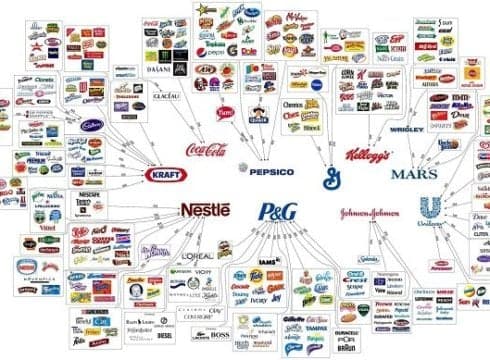Inc42 Daily Brief
Stay Ahead With Daily News & Analysis on India’s Tech & Startup Economy
A chart we found on Reddit.com today shows that most products we buy are controlled by just a few companies. It’s called “The Illusion of Choice.”
Ever wonder why you can’t get a Coke at Taco Bell? It’s because Yum! Brands was created as a spin-off of Pepsi–and has a lifetime contract with the soda-maker.
Unilever produces everything from Dove soap to Klondike bars. Nestle has a big stake in L’Oreal, which features everything from cosmetics to Diesel designer jeans.
Despite a wide array of brands to choose from, it all comes back to the big guys.
Ten mega corporations control the output of almost everything you buy; from household products to pet food to jeans.
$84 billion-company Proctor & Gamble — the largest advertiser in the U.S. — is paired with a number of diverse brands that produce everything from medicine to toothpaste to high-end fashion. All tallied, P&G reportedly serves a whopping 4.8 billion people around the world through this network.
$200 billion-corporation Nestle — famous for chocolate, but which is the biggest food company in the world — owns nearly 8,000 different brands worldwide, and takes stake in or is partnered with a swath of others. Included in this network is shampoo company L’Oreal, baby food giant Gerber, clothing brand Diesel, and pet food makers Purina and Friskies.
Unilever, of soap fame, reportedly serves 2 billion people around the world, controlling a network that produces everything from Q-tips to Skippy peanut butter.
And it’s not just the products you buy and consume, either. In recent decades, the very news and information that you get has bundled together: 90% of the media is now controlled by just six companies, down from 50 in 1983, according to a Frugal Dad infographic from last year.
It gets even more macro, too: 37 banks have merged to become just four — JPMorgan Chase, Bank of America, Wells Fargo and CitiGroup in a little over two decades, according to this Federal Reserve map.
The nation’s 10 largest financial institutions hold 54% of our total financial assets; in 1990, they held 20%. As MotherJones reports, the number of banks has dropped from more than 12,500 to about 8,000.
The numbers are stark, and the charts visualize the mind-bending reality. This is the world we live in.
Note: We at Inc42 take our ethics very seriously. More information about it can be found here.


